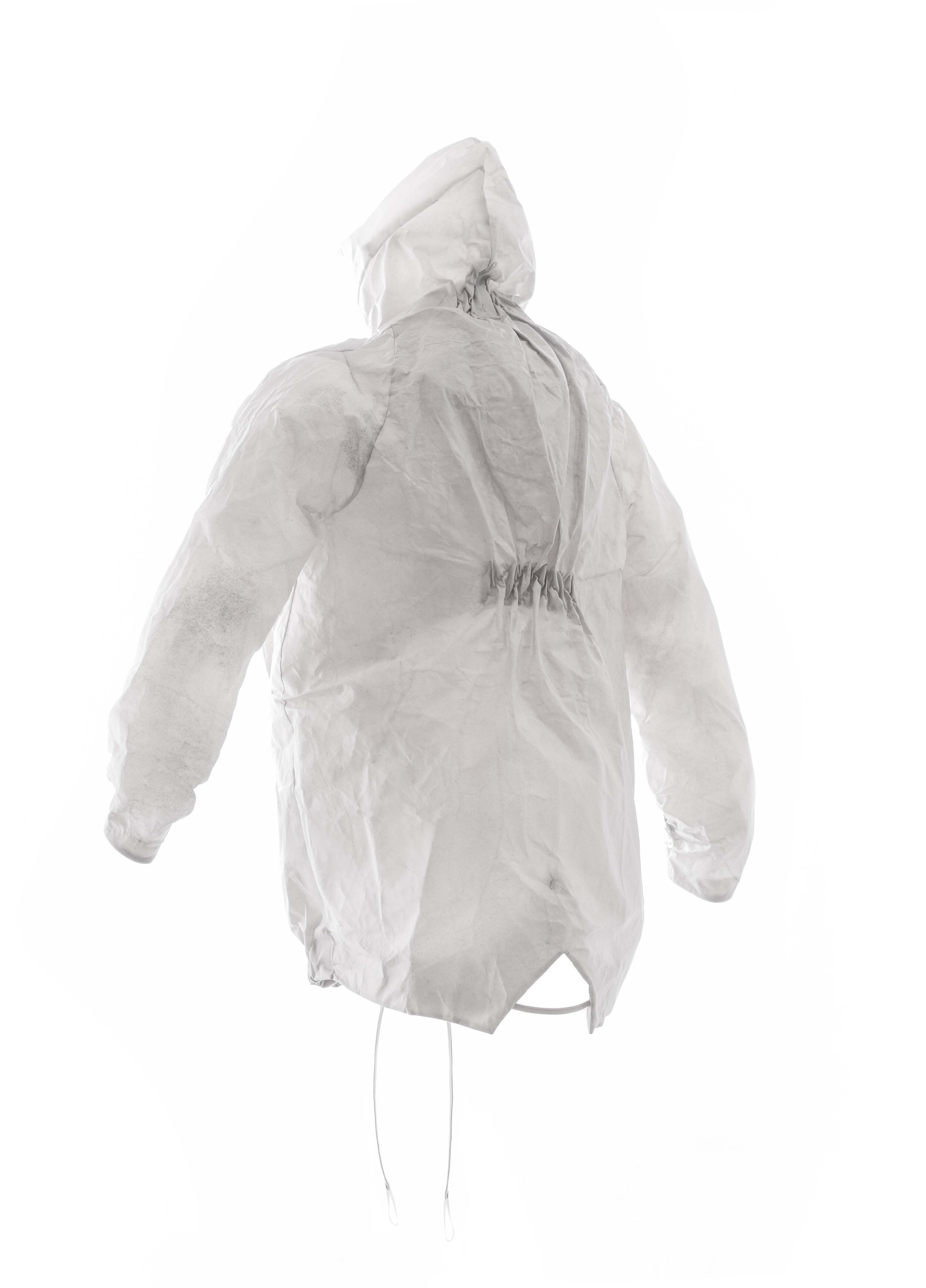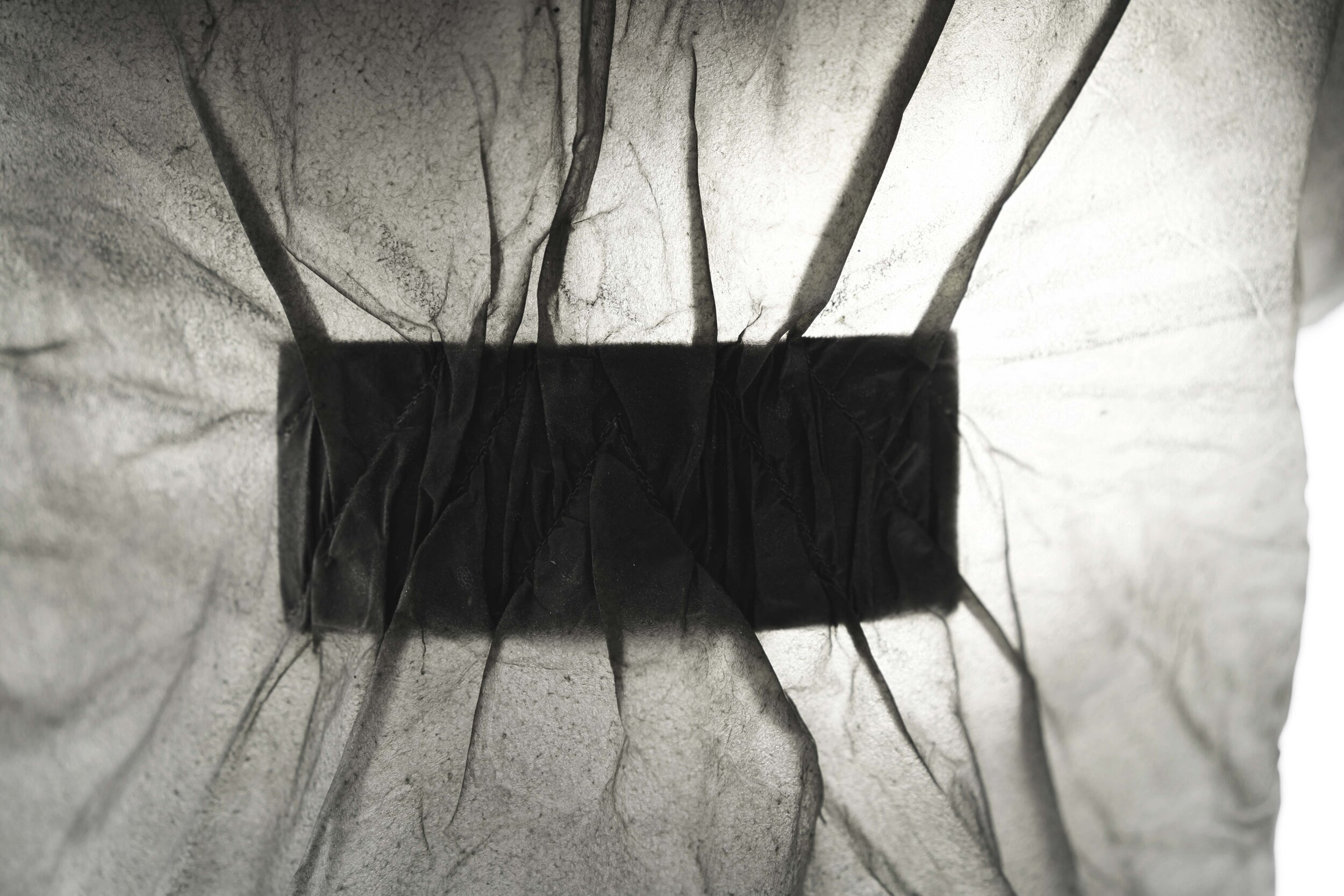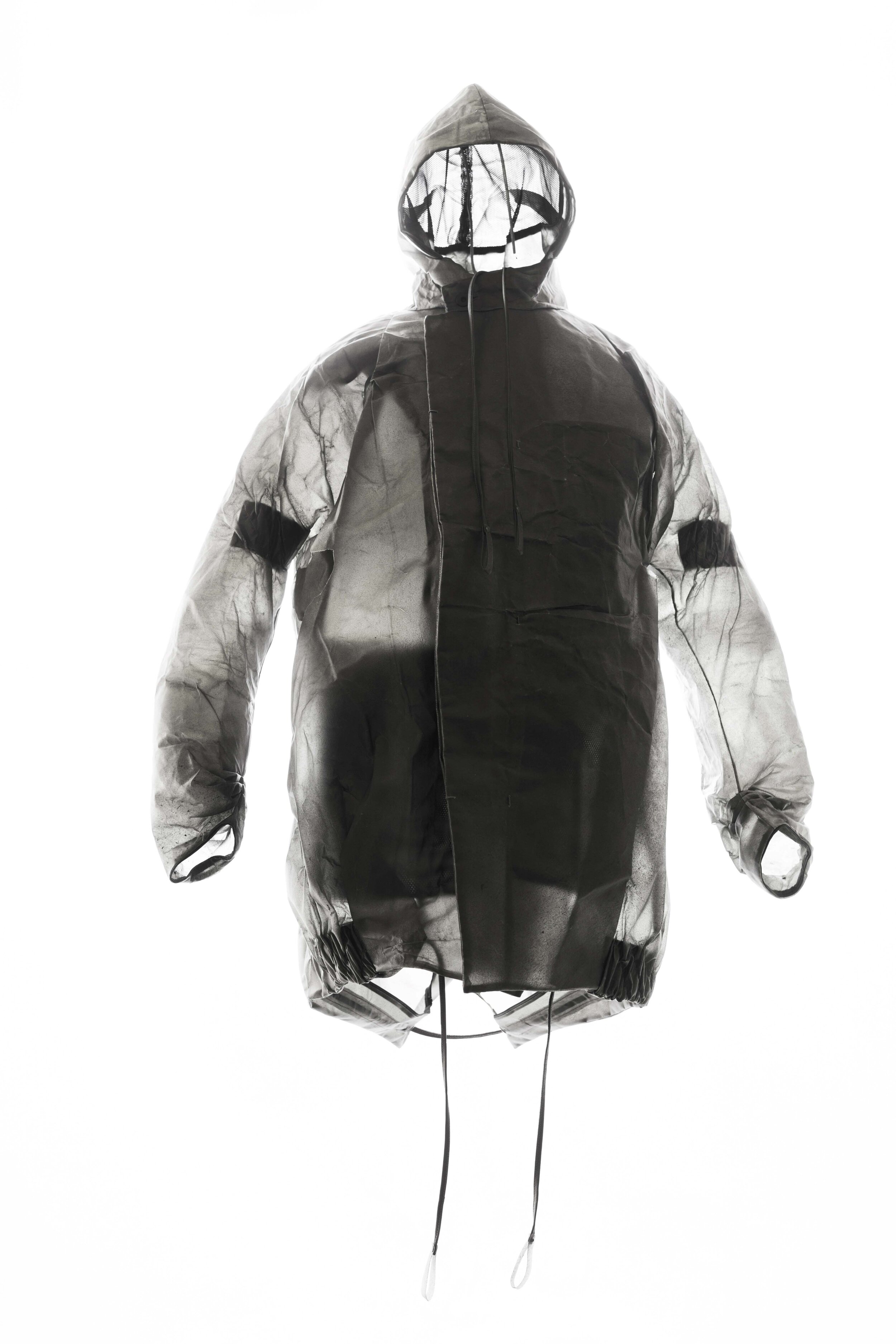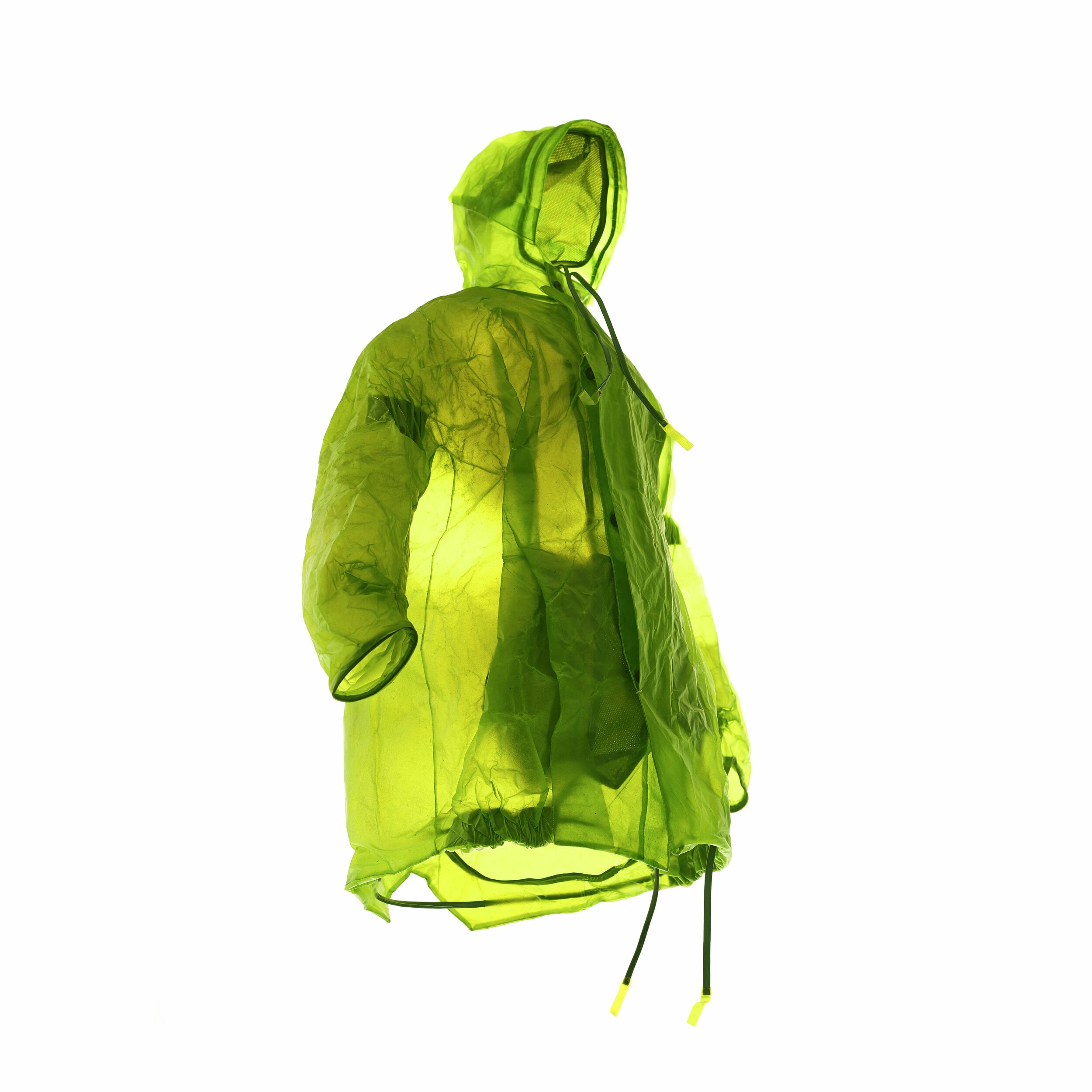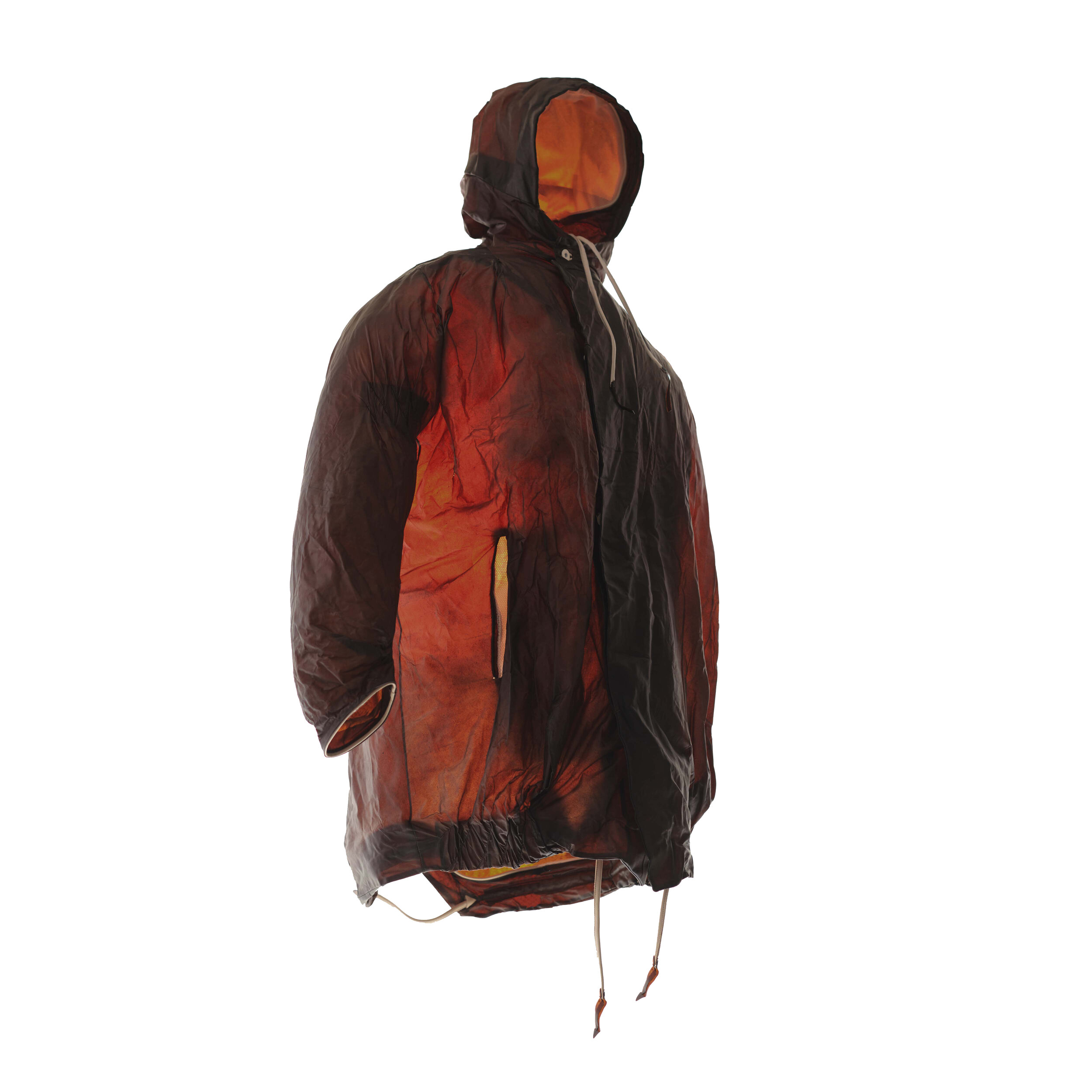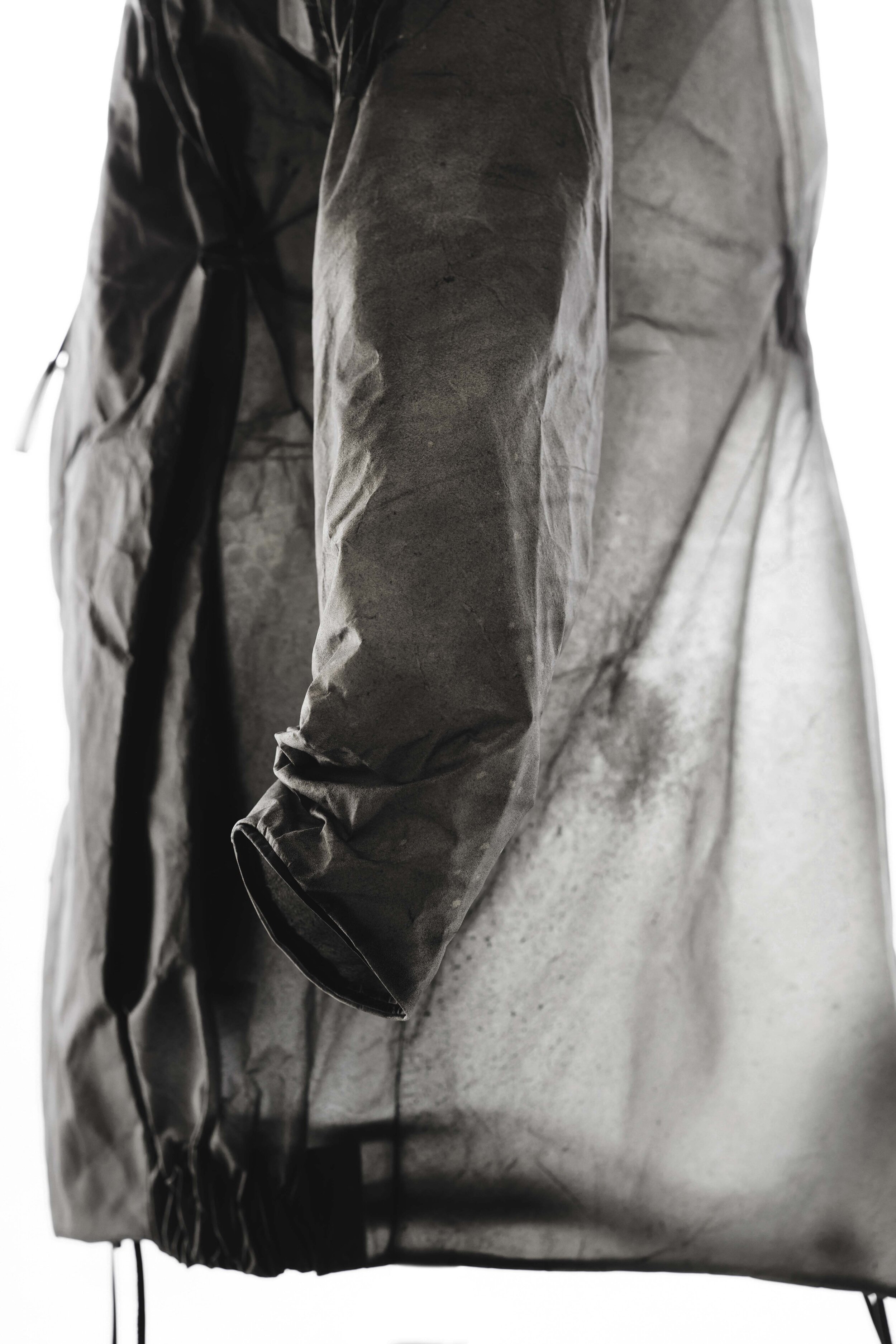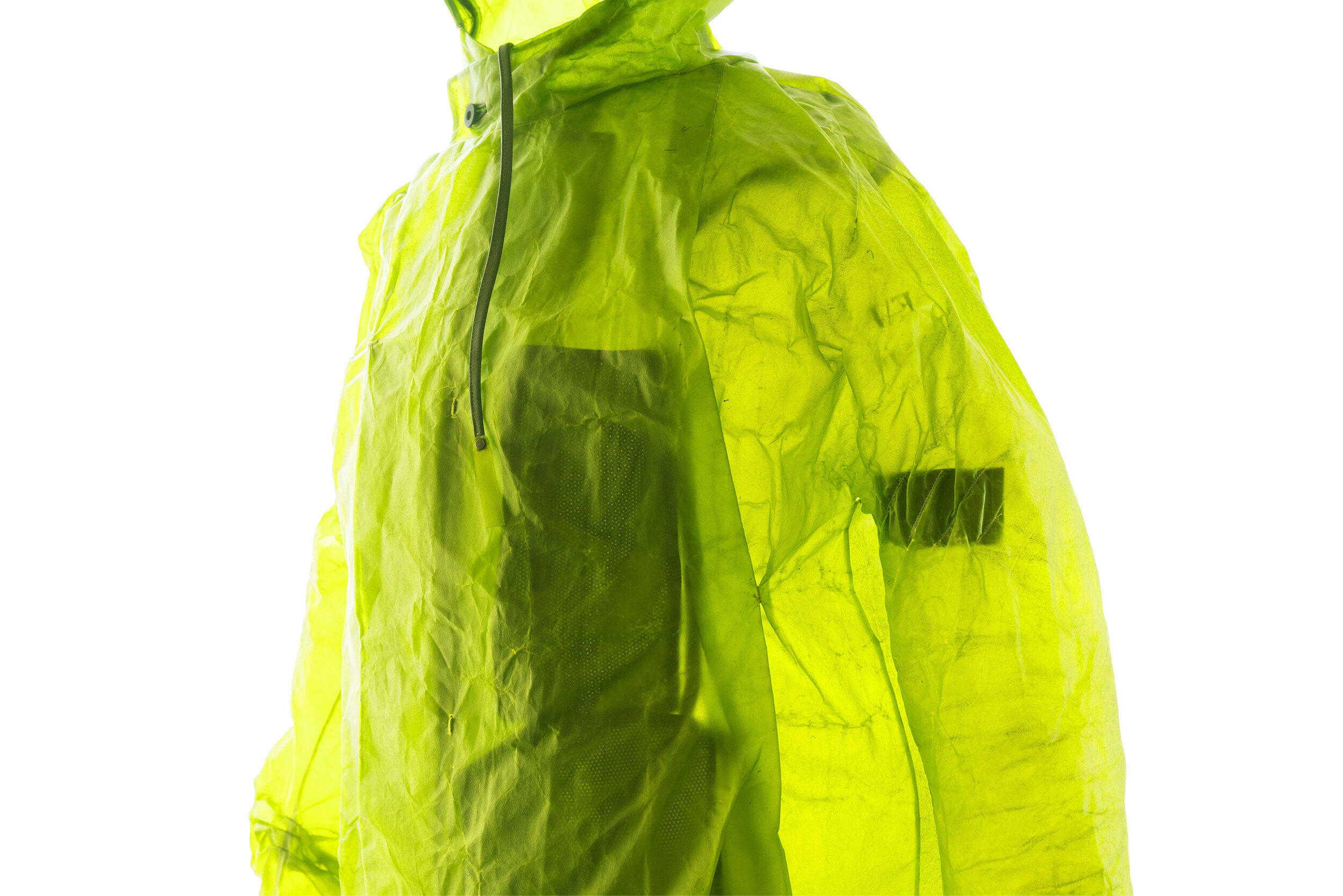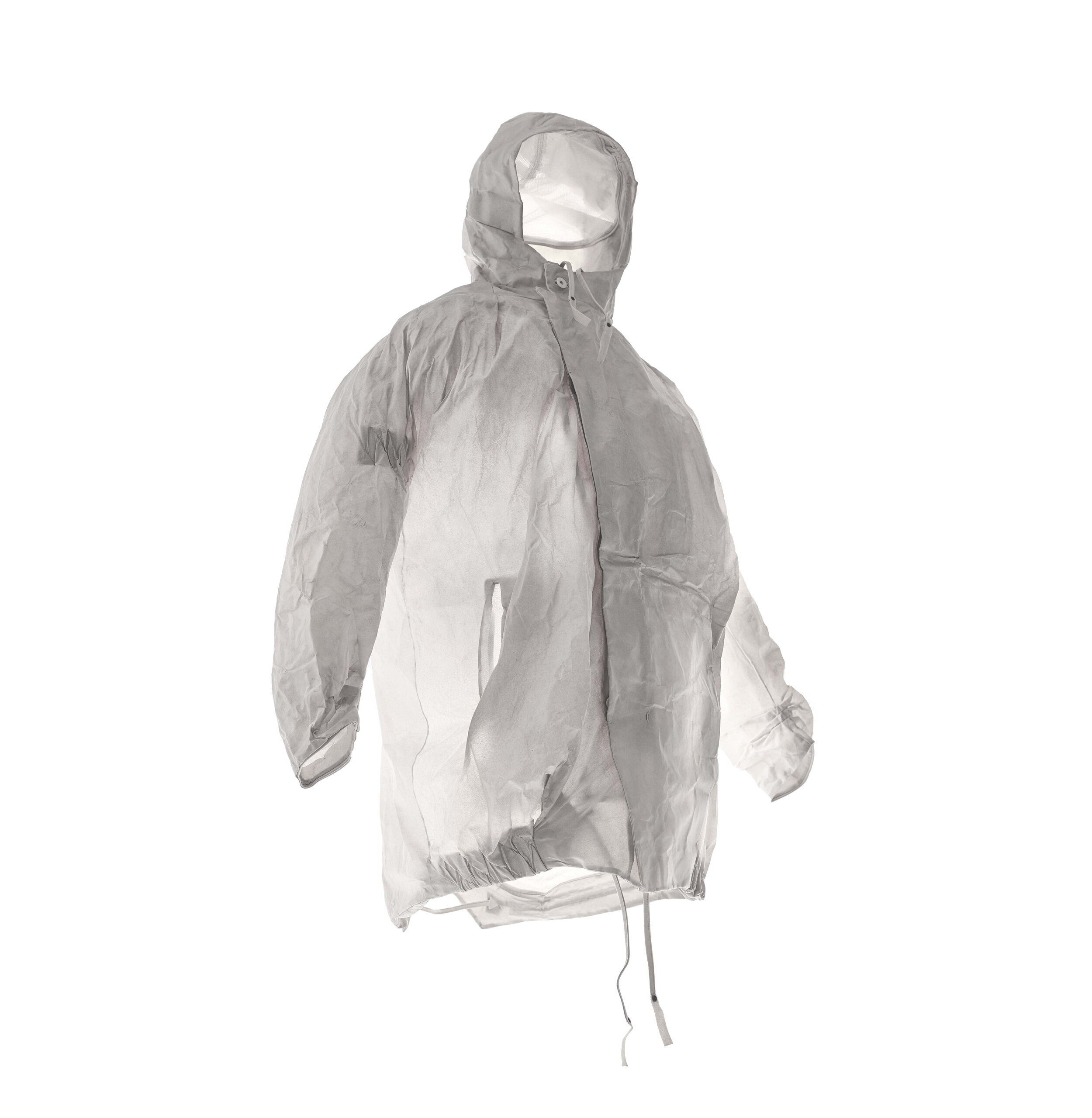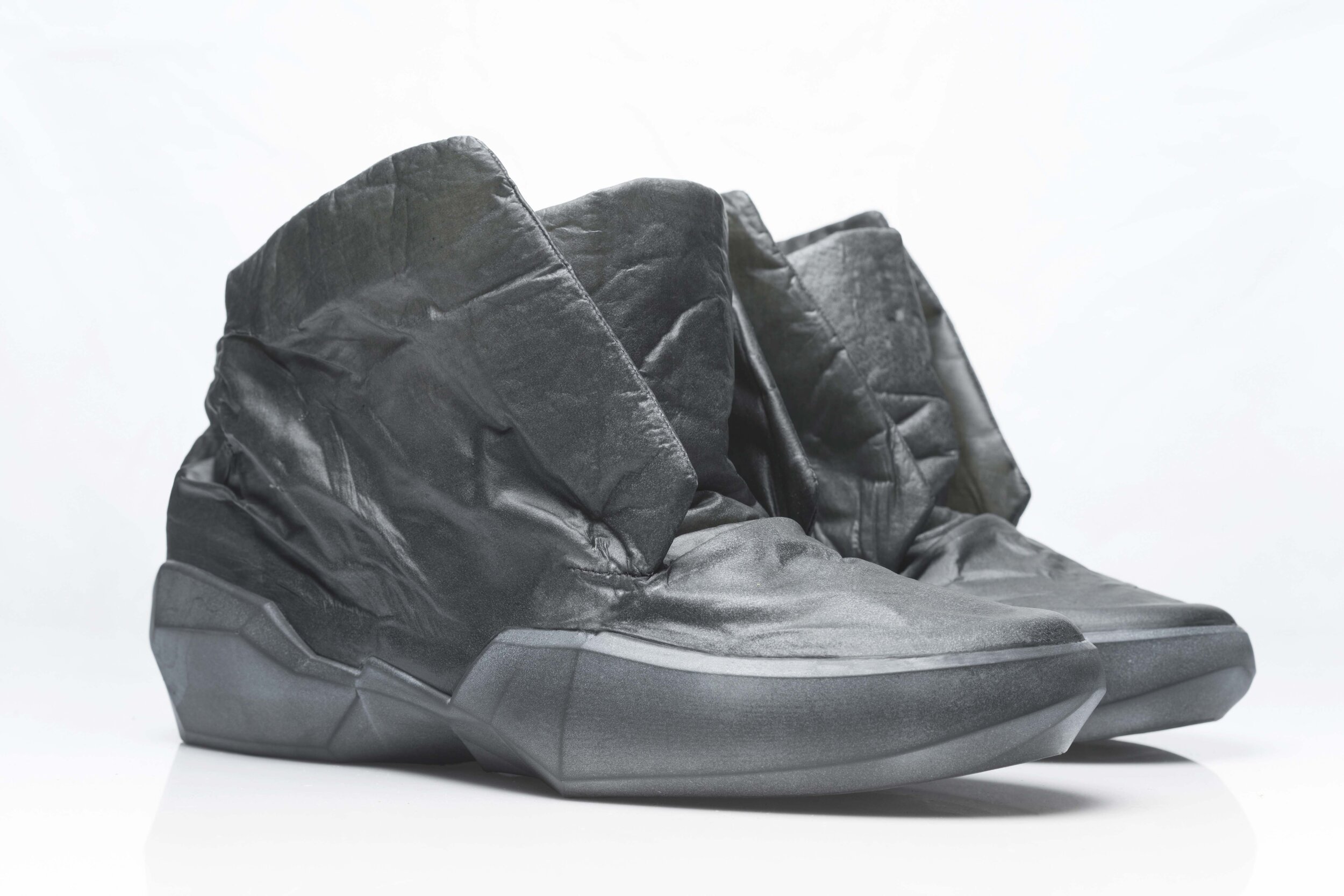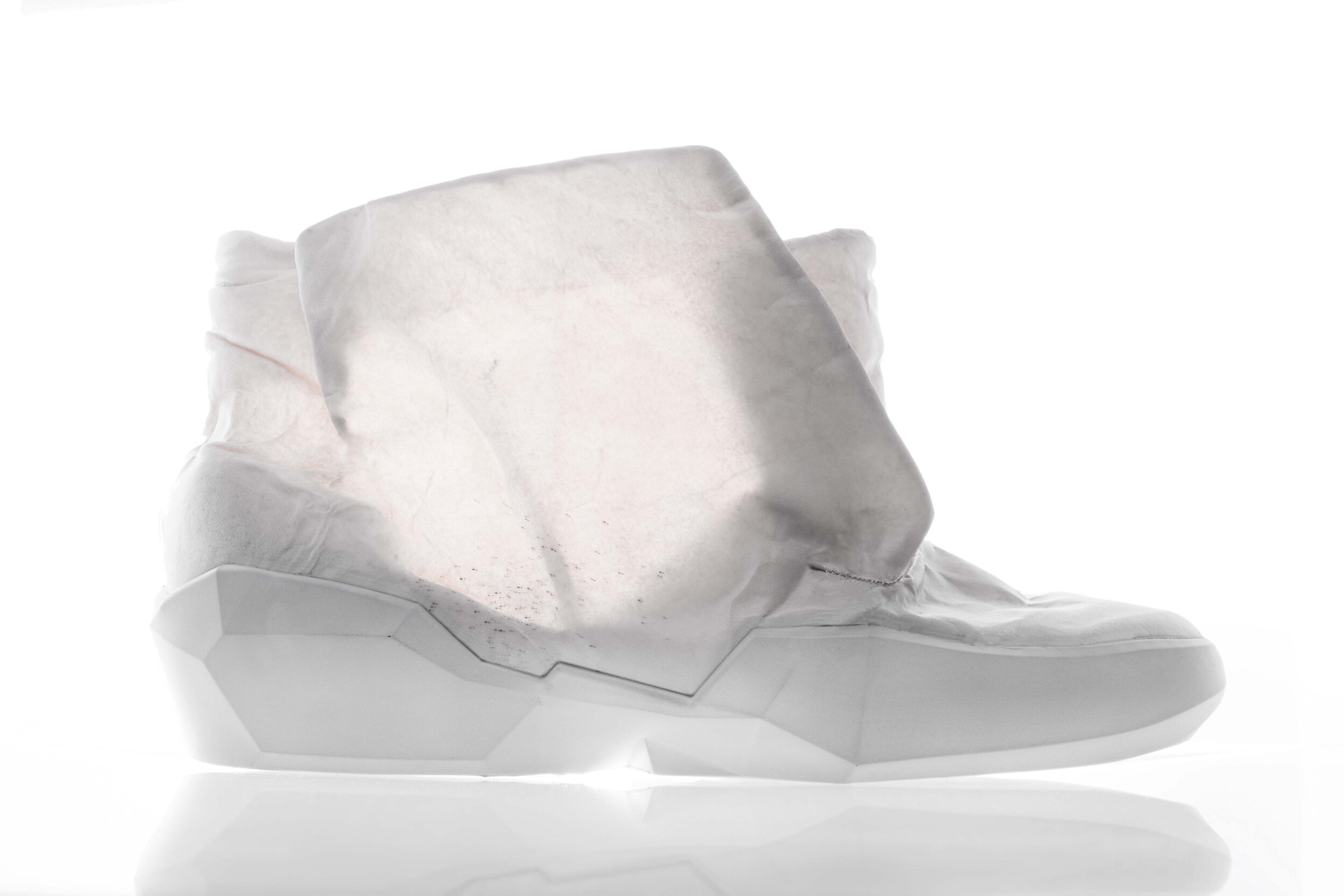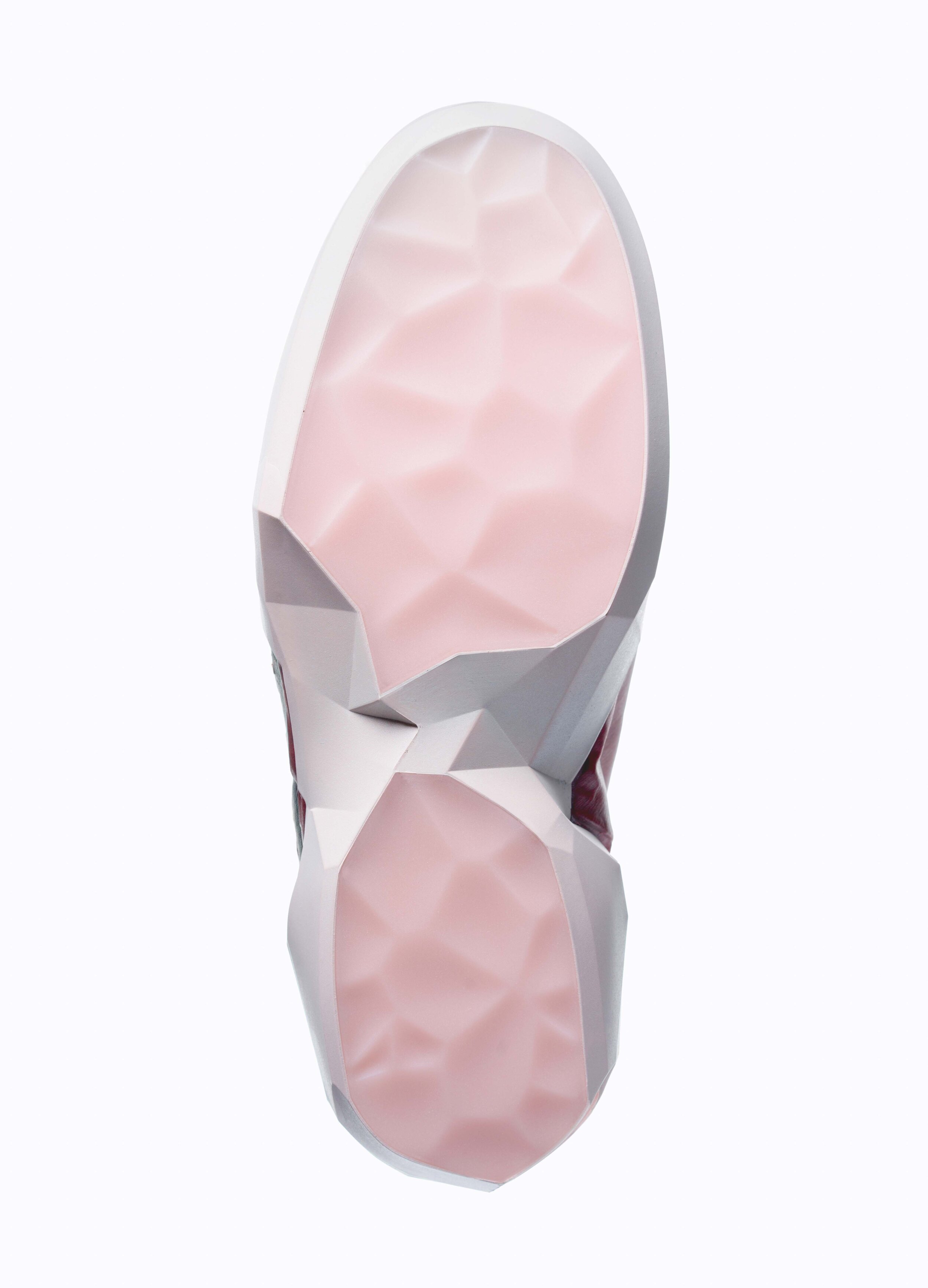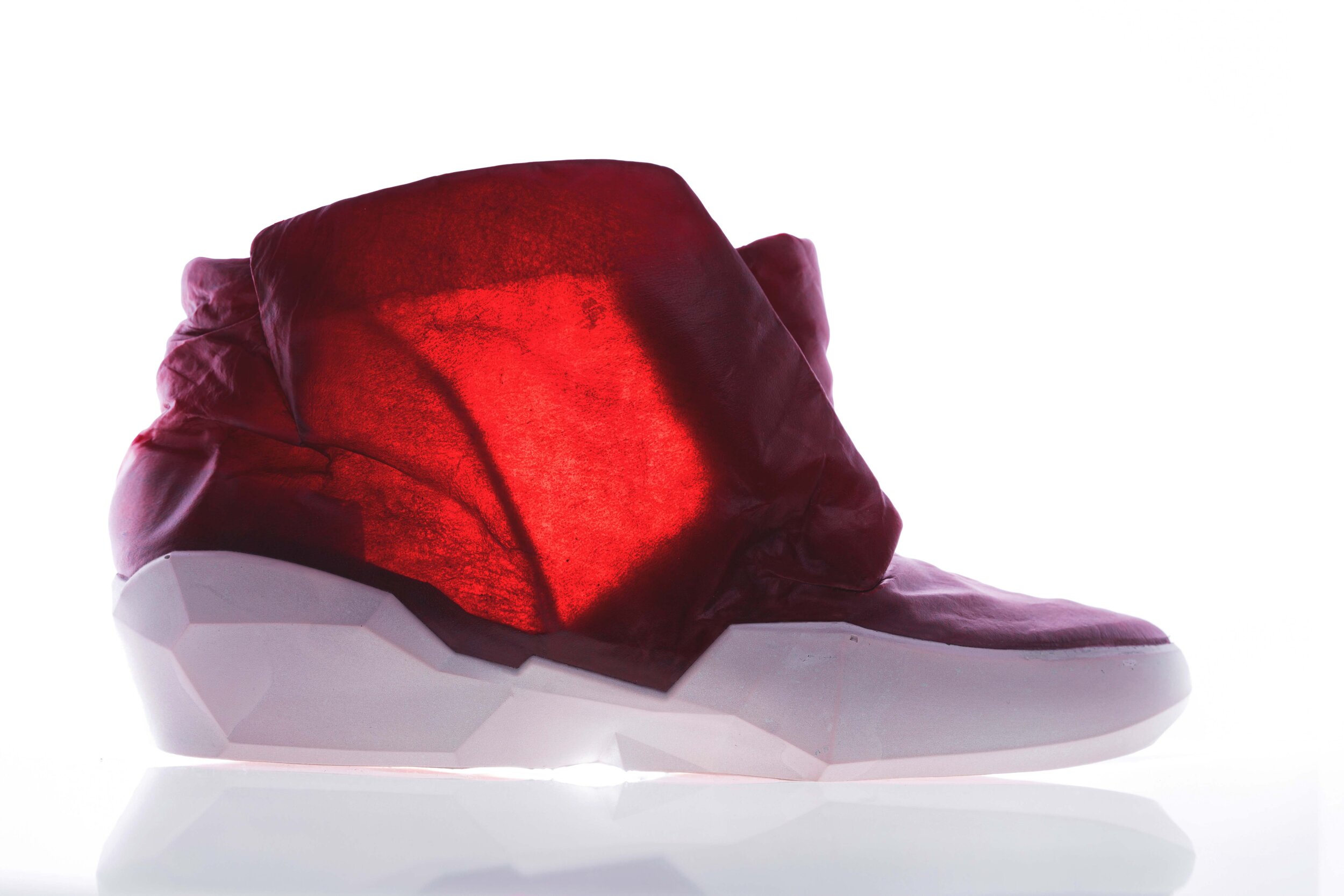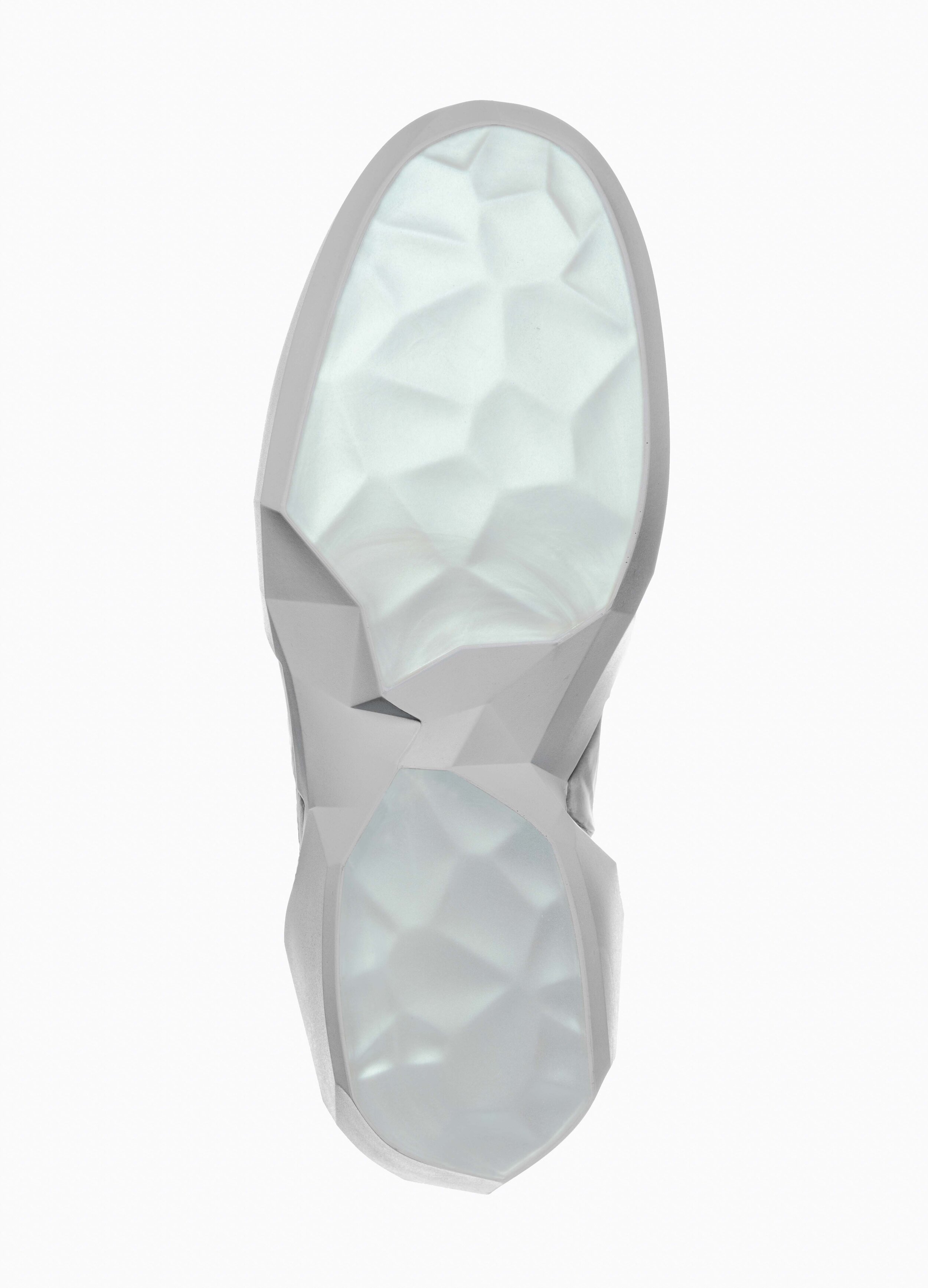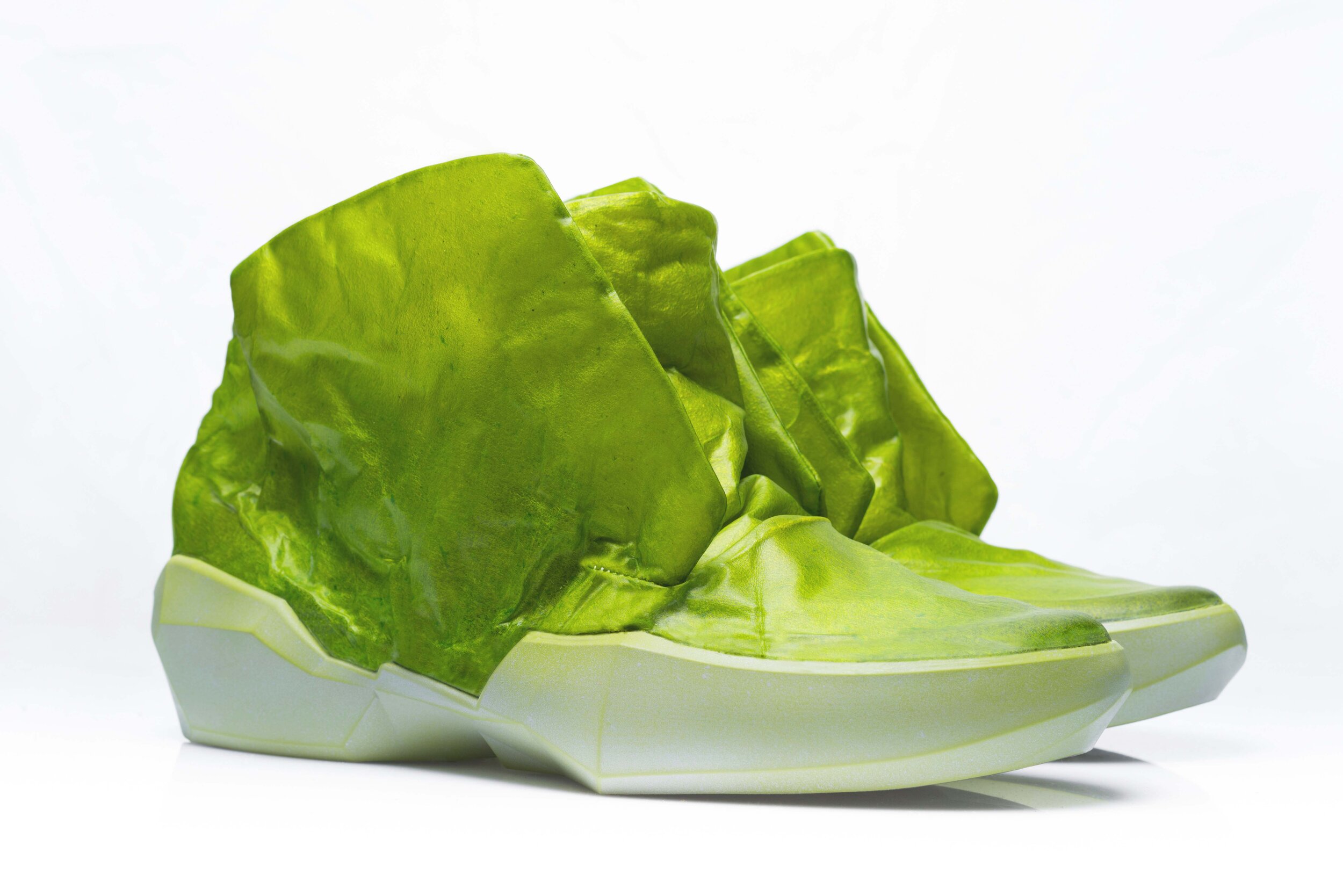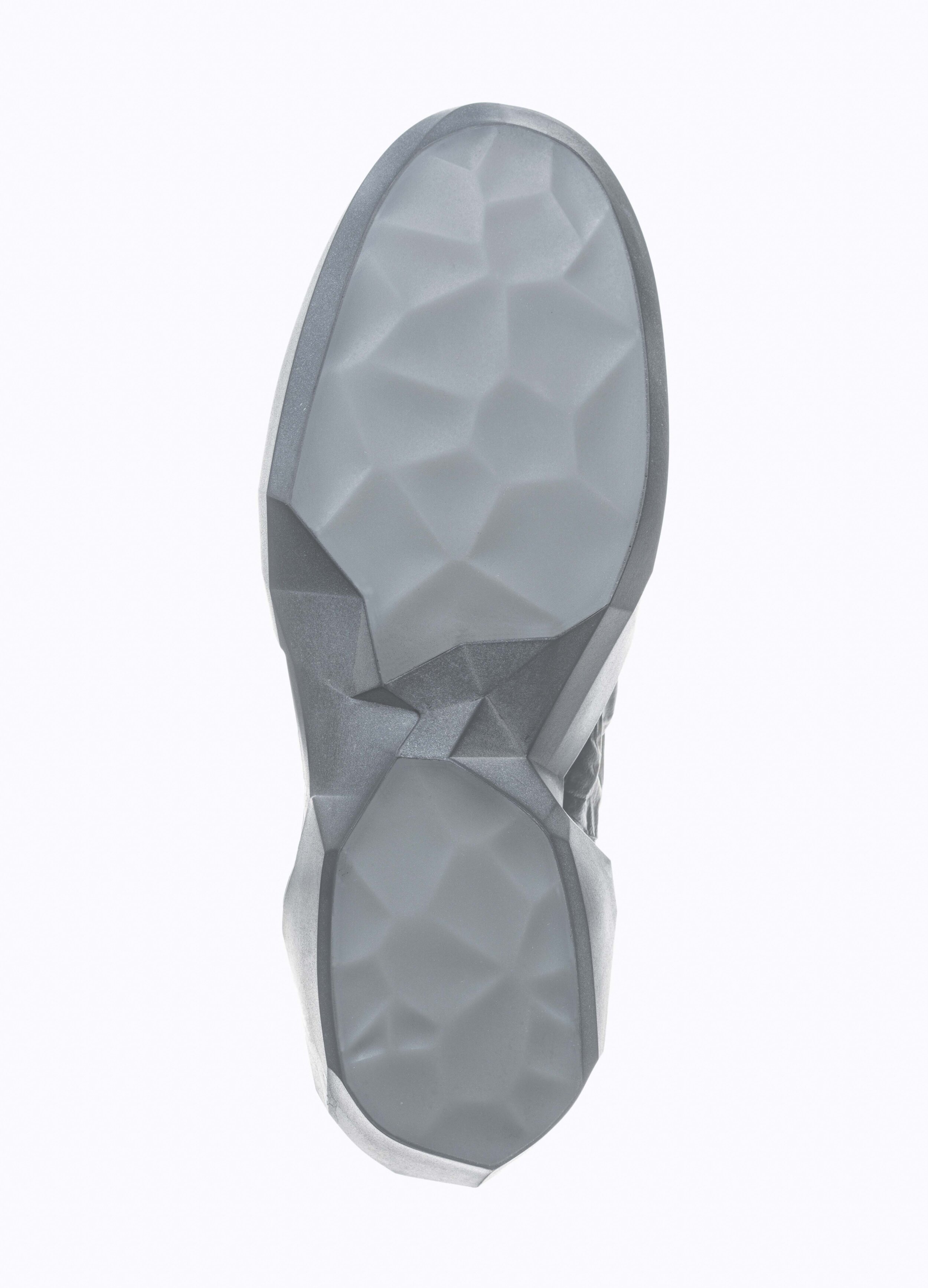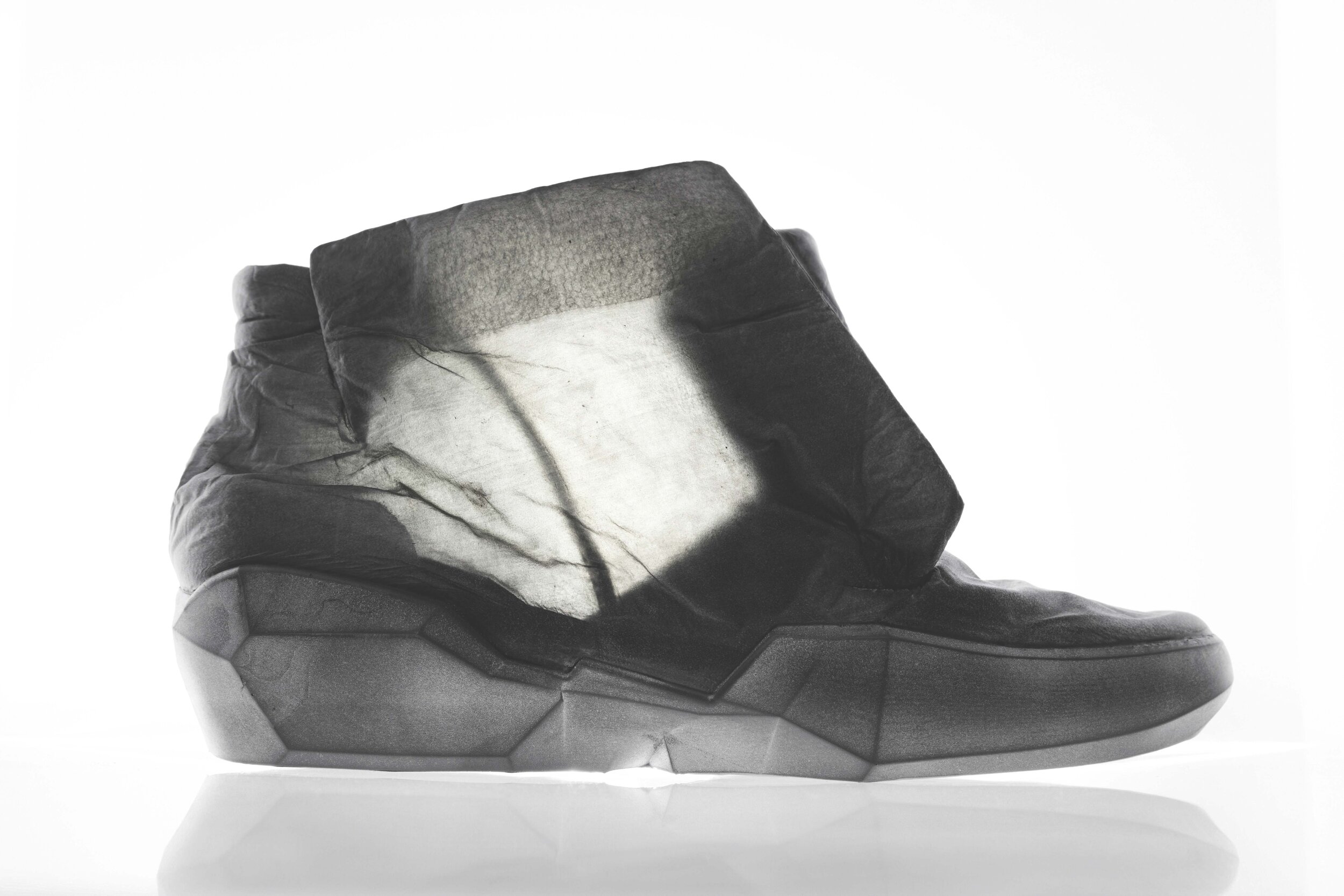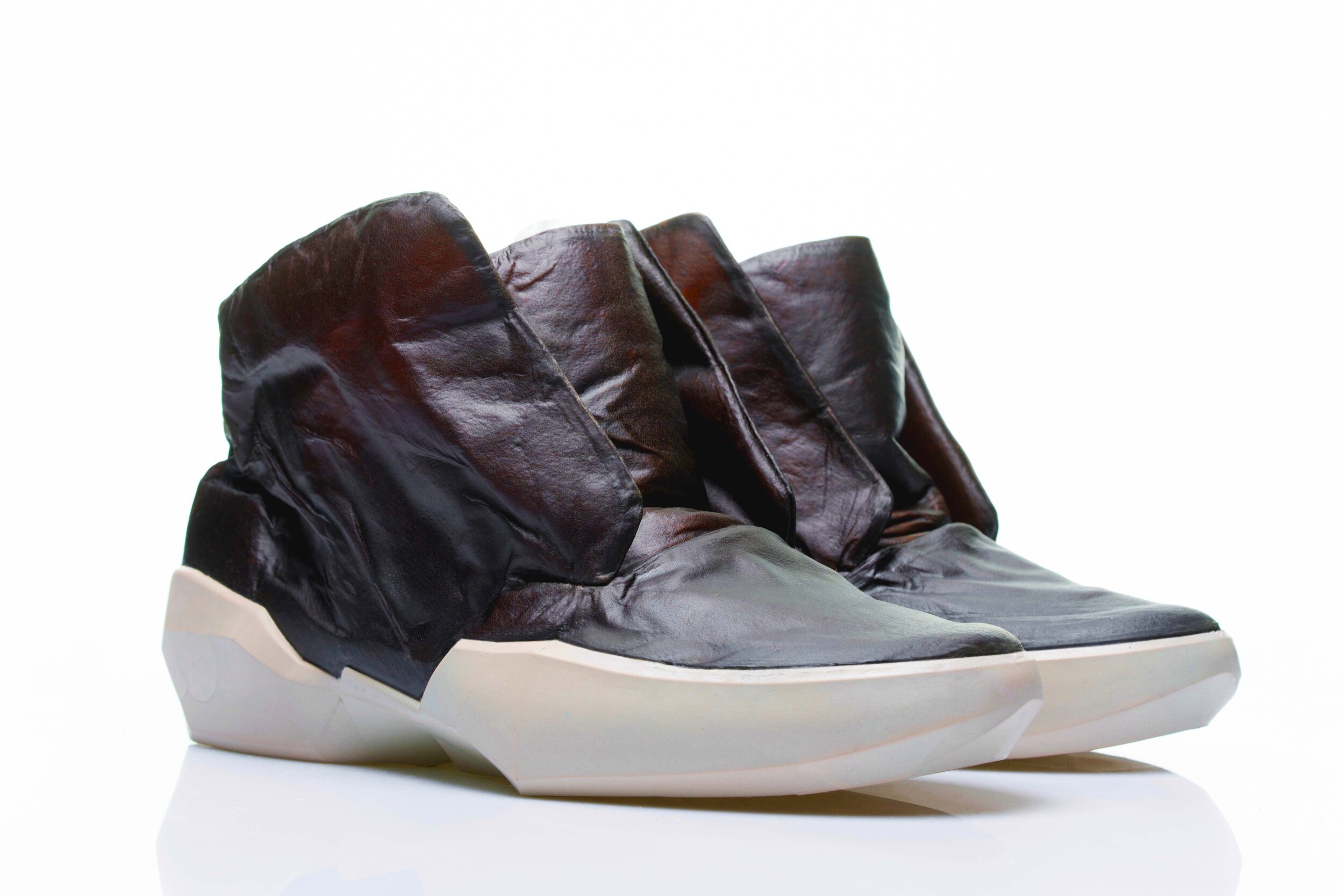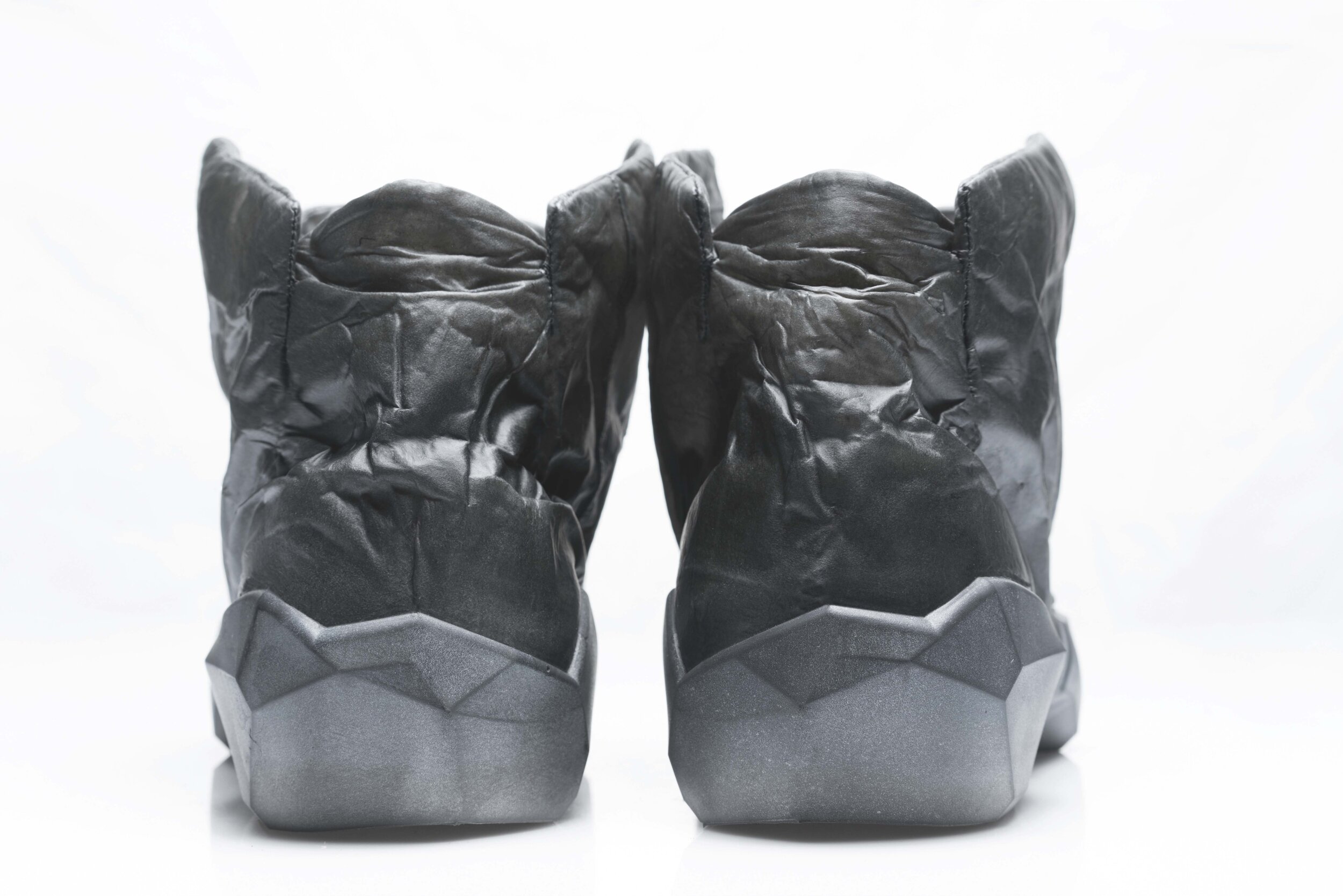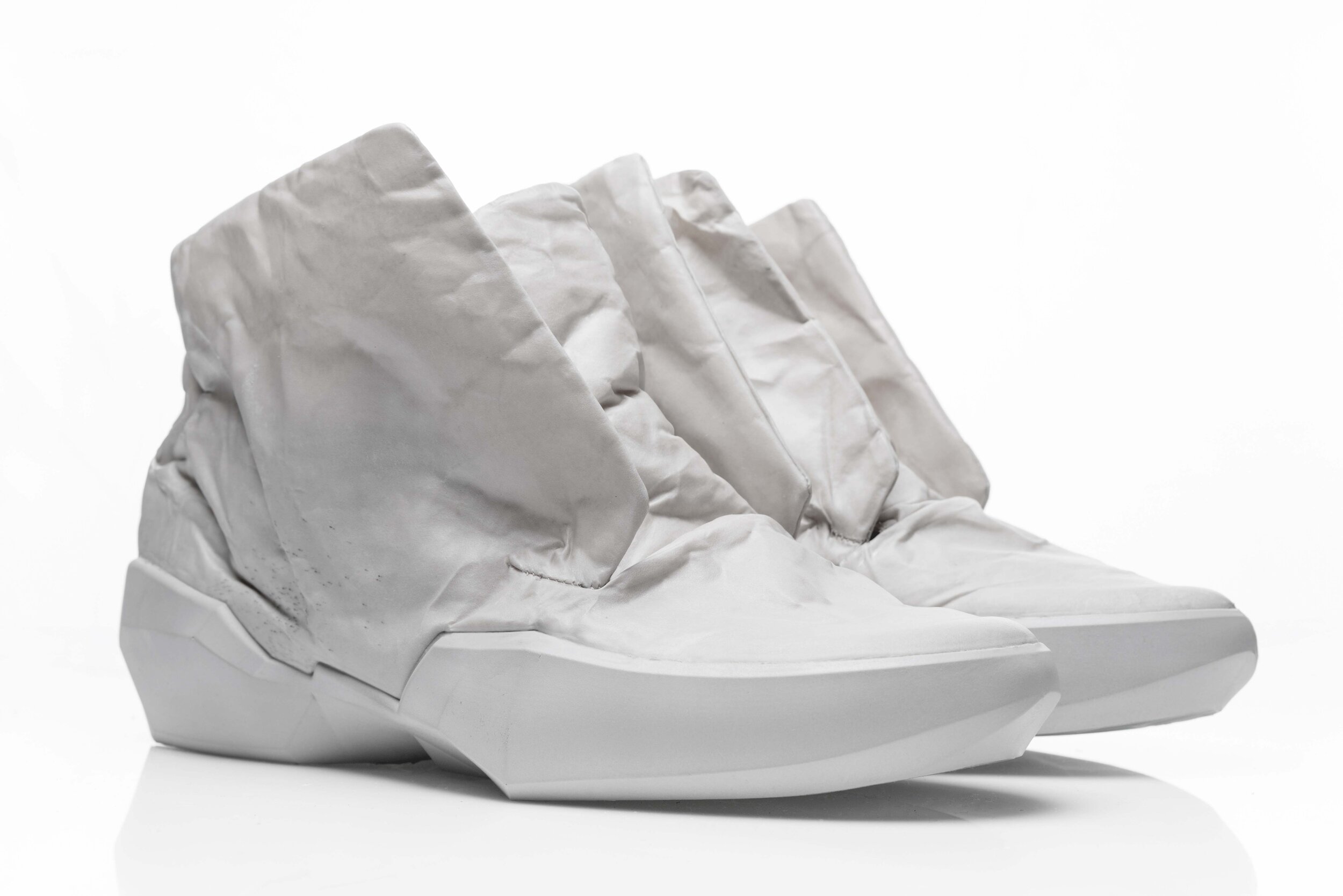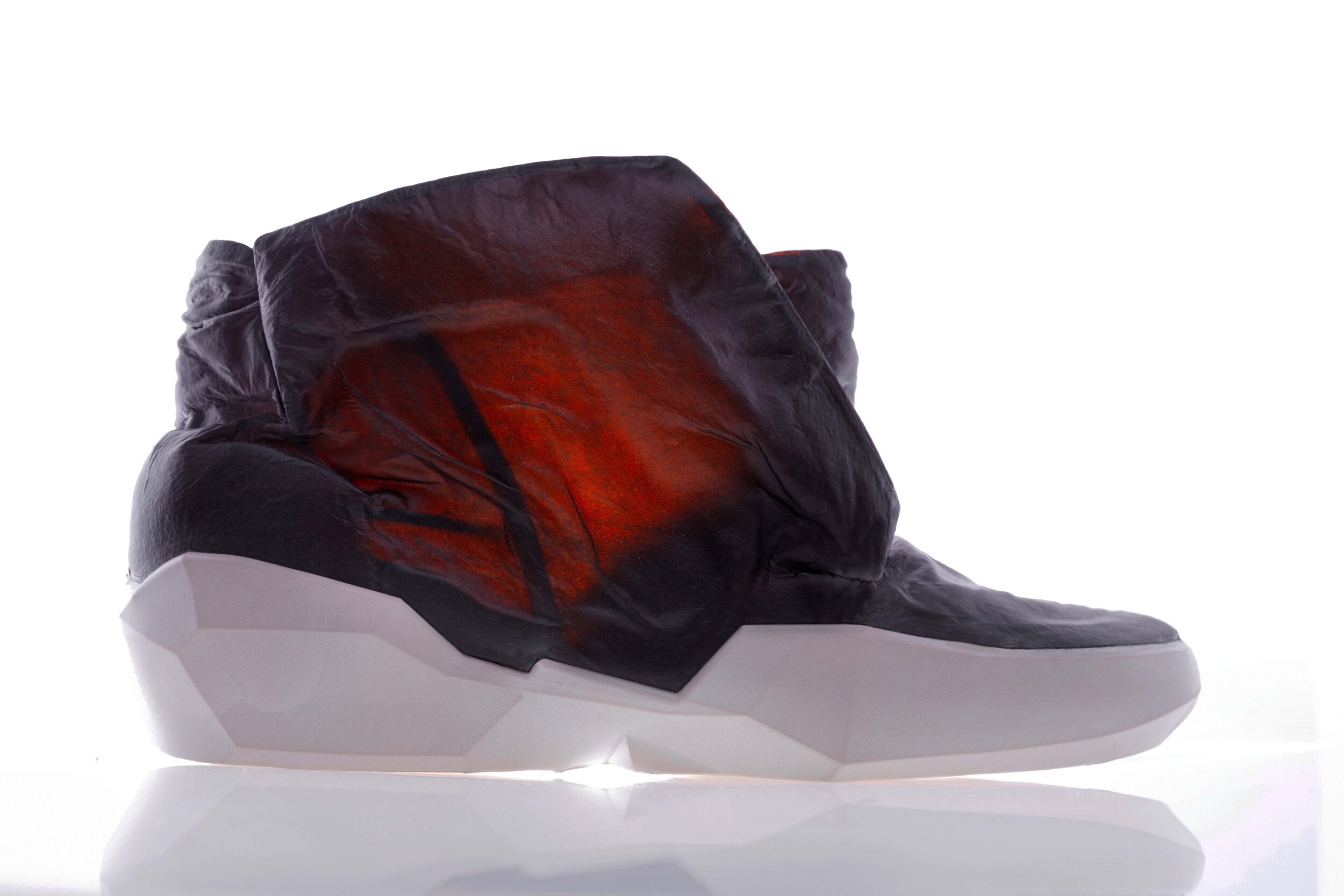Ecco Leather - Chapter I
Apparition
Translucent Leather
The quest for transparent leather has long eluded both tanners and designers. While transparency was previously possible with the significantly smaller hides of goats and sheep, these skins had a big problem: while you could see through it, the leather was hard like parchment. And it couldn’t get wet. Ever.
Photography - Marinó Thorlacius
A team of 40 people at ECCO Leather rose to the challenge and after five years of intensive R&D created soft and waterproof transparent leather – pliable, strong and easily workable. Available in a range of rich and controlled tints, this revolutionary new material is now ready for designers and brands to embrace.
Named Apparition for its spectral qualities and almost ghostlike appearance, the leather was then applied to the design of garments and shoes.
APPARITION - FILM
Apparition - Soft Transparent Cow-Skin Leather
This film was developed to showcase the spectral properties and softness of the Apparition leather.
We worked with choreographer Sigríður Soffia Nielsdóttir to develop a performance of systems that orbit each other, based on the eclipse of planned obsolescence - the theory that you are the centre of a universe of products you own, and every product is orbiting around you, each with it’s individual date that it will break.
This suggests that the reason why several objects in your life break at the same time is to do with the obsolescence eclipse in effect. The astral product bodies aligned and eject their primary state while dancing in disfunction.
And in this film you see the dancer Andri revolve around and through himself. Again. And again. And again, until he had worn through the skin in his feet.
This shoot was oldschool, painful and complex. Like love.
Construction - Flavia Bon
Performer - Andrean Sigurgeirsson
Choreography - Sigríður Soffia Nielsdóttir and Andrean Sigurgeirsson
DOP - Marinó Thorlacius
Editing - Stefanía Thors
Original Score - Helgi Svavar Helgason
VFX - electricpig
Makeup - Steinunn Þórðardóttir
Production - Femke Van Seeters and Marlie Louwers
Graphic Design - Birk Marcus Hansen
FILMED IN ICELAND
2017
Apparition
Transluscent Leather Coat
The initial plan was always to make it into a material that could replace plastics in raincoats, shoes, and bags for the premium market, making it usable, accessible, tactile, and desirable. Finally, [we had] to commercialize it – not just have it as an artisanal fancy you see online.
This is a very good example of applied R&D focusing on an end goal, and not stopping for any obstacles. From early on we could see the garment and shoe types that I would benefit from this.
So much of what we work on can only be shown a year or two after it happened.
It's either tied up by a confidentiality agreement, or by showing the work in progress it will spoil the reveal.
Apparition
Transluscent Leather Shoe
This project though, The APPARITION translucent leather, from 2017 is a mind blowing achievement in so many ways.
This is one of the projects we spearheaded while running the creative direction for the innovation lab of @Eccoleather. The intention was to push for game changing leather advances - APPARITION was the first material released to public.
Large-scale translucent leather skins had not been produced effectively to make them commercially viable.
Thus, a challenge.
And as usual, I am attracted to something that cannot be done.
The aim, first and foremost, was to make a new material [then] tell it as a story through product and imagery.
Stylezeitgeist Interview
BY EUGENE RABKIN APR 27, 2017
We are always eager to learn about the new projects from the Iceland-based designer Sruli Recht, who has successfully transcended fashion design and who is more of a mad scientist in the best possible sense of the word. His work consistently brings future into the present, science fiction into reality, and so we were not surprised to learn about his new project with ECCO Leather experimental lab, called APPARITION, for which Recht has developed the first commercially viable translucent leather. Our Q&A is below.
Eugene Rabkin: How did the idea to collaborate with ECCO Leather come about?
Sruli Recht: I began working creative direction with the ECCO Leather innovation projects late 2015 after taking part in their annual Hotshop. The Hotshop is a kind of a lab that allows professional creative to have unbridled access to R&D and technicians in a creative and open way, because usually experimental efforts are hampered by massive R&D costs and unattainable minimum order quantities to make them viable. The options to experiment with such a costly material and such a time-consuming process gives me an opportunity to follow my intuition in development and make something unique without being confined to what can be coerced from reluctant sellers at trade shows.
During this collaboration, I was able to [and have continued to] work closely with Panos Mytaros, the EVP, a rebellious seventh generation tanner, and we explored leathers with focus on tactile aesthetic, pushing past engaging with leather only visually, and trying to find new sensorial experiences for the fingertips. This is especially important today, when most people engage with fashion design through photographs and websites and an education in tactility is a rare thing. Hence we now have a generation of designers with a developed skill in look, but not material properties, such as handling, temperature, movement.
During the workshops, it was phenomenal to discover ways of making paper-like leathers, sodden waxy pillowed spongy leathers, and applying various chemicals such as acids to structure the back of the skin, in combination with camembert type nap that when used together distort the experiential nature of the skin – a peach-like fuzz that pushes back with a surprising tension.
And so, after this intense period of hands on rapid leather development, the conversation naturally segued into what we could achieve with a lengthier period of provocation. And that’s how this project, which we called APPARITION, was born.
ER: What was it like to work with the ECCO R&D lab?
SR: It is really an otherworldly experience. You are walking on the shoulders of giants in the large halls of such an advanced tannery. It can be said that working with an R&D and team like this is similar to the improvisational “yes and…” approach. There is no “no”, but “let’s try,” which is good for reactive personalities like mine. Makis Sachperoglou, the senior tanner, is a savant – he usually knows what he doesn’t know, but that he will at some point, probably while doing something else, like oiling his lounge. Panos himself has always pushed a “respect tradition, destroy convention” attitude.
And so it’s an incredibly positive team that enables the material junkie to level up in ways you won’t find in other tanneries where often the creative arm is often stationed at the table in the staff kitchen.
At first, in a place like this, it can be overwhelming when you have every machine, color, and chemical handled by several generations of incredible leather knowledge. You can literally do anything… and so where to begin? It can be easily disorienting when this much choice is in front of you. Control is necessary in this type of “anything is possible” distortion field. However, there is a time and place for spontaneity.
ER: Why did you decide to develop translucent leather?
SR: In my past work, I had used various types of parchments and vellum skins with translucent qualities, such as lamb, goat, and fish, though they all have their limitations in scale, and more so in application. You could soften it by treating it, but it would invariably dry up, and you couldn’t let it near any type of moisture or it would absorb, swell, weaken… then tear. We could use it for firmer objects, more interesting faceted forms where the spectral achievements were based on flat versus fold. But this really isn’t leather, the stable material we are accustomed to. I had been looking for a material for outdoor garments that could be both translucent and still feel nice to touch, and yet not be plastic, to keep within the framework of the collections and size of our pattern pieces. Being exposed to the options at the tannery and their eagerness to experiment meant it was possible to try.
The simple answer is, large-scale translucent leather has not been produced effectively to make them commercially viable. Tanneries either did not want to invest in the R&D, or did not see the market possibilities, or perhaps did not have a client willing enough to work it out. Thus, a challenge. And as usual, I am attracted to something that cannot be done.
Some things are plain hard, and by that nature invariably attractive. These are the moments when creative and scientific minds endeavor to plant the first footprint in the dust. A “go science” type establishment such as ECCO Leather says something like, “Go out into the dark forest, with not enough food or clothing, freeze, hurt yourself, pass through the sharp flames and come back changed, holding in your left hand the remnants of your shattered ego, and in your right something new, tempered from the hydraulic pressure of what happened.”
When we started this, we assumed it could take several years. But ECCO Leather believed that there was value in developing translucent leather beyond what an artisanal brand could do with it. During these innovation marathons, the question came up whether it was truly possible to achieve this type of thing, soft, non-funky, and a non-tearing leather that wasn’t the color of various stages of oxidizing urine.
It made sense of course that if we could replace plastics with leather the luxury market would be more inclined to use it, too. The first coat we made from this leather is still soft after a year and half of testing.
ER: How does this leather differ from previous efforts of other designers?
SR: Let’s rewind back a little – All skins during the tanning process become translucent at a certain stage before the final tanning process. Vellum for example is a well-known form of translucent skin, used in the past for book binding, and this is where designers, including myself, have used it to create objects and garments. However, these skins are not finished or stable. They are still reactive, meaning their molecular bonds are still open, and so they will become hard in short time, or grow bacteria, and can never be exposed to moisture. In most cases this is where the tanning agent comes in, closing the bonds, and at the same time the leather loses transparency.
We, on the other hand, managed to stabilize the skin at the point of translucency, add color, keep it supple, waterproof, and do all this with enormous cow skins. This stuff can be cut, sewn, and worn. It is soft and matte to the touch, not oiled or dehydrated. It’s an actual commercial material.
No doubt several tanneries, students, and designers have presented other types of skin with spectral qualities, but this is the first successful effort that goes beyond mere experimentation. This means the skins are 4-8 times larger than what has been available to the fashion industry before. The coats that you see in these images are made from one uninterrupted skin from a one-piece pattern.
ER: How did your experience differ from a typical commercial operation?
SR: It’s always a race to who is going to discover or use a new material or technique first. Within this segment of the market much attention is paid to the intersection of craft, technology and trial. Where ideas are the currency of innovation, usually the first one to stake their flag in something like this essentially owns it; your suppliers and producers are closely guarded secrets. This effort is a little different – you see the aim of these projects by ECCO Leather is to create new materials, present them as objects to express the nature of the discovery, and then contextualize it in a narrative form. That is what you see here in the APPARITION project, all three things coming together – material, design, story.
ECCO Leather itself is not a product manufacturer, so in this way they are able to invest in creating new material and narrative for a greater world of designers to use.
This leather is an evolution, as is all aspirational material developments – lighter, stronger, thinner… the goal to most material science. Where we have begun with coats, shoes, gloves and bags, we can go to translucent furniture and all the way across the board to things we don’t yet know. I would be lying if I didn’t want to keep this material exclusively for myself, but this really is larger than any one designer.



